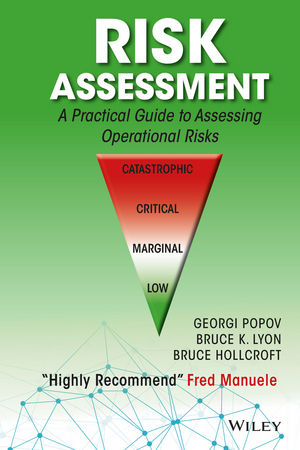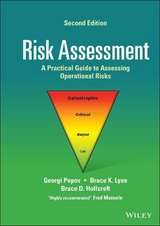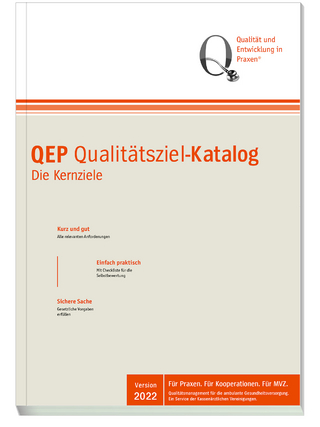
Risk Assessment
John Wiley & Sons Inc (Verlag)
978-1-118-91104-4 (ISBN)
- Titel erscheint in neuer Auflage
- Artikel merken
Georgi Popov, PhD, QEP, CMC, is associate professor at the University of Central Missouri where he teaches risk assessment. His research interests include industrial hygiene, safety management, risk assessment, PtD, air quality, alternative fuels, LEAN Six Sigma practices, and business aspects of Environmental, Health and Safety. His experience is unique with both civilian and military environmental, health, and safety programs. Bruce K. Lyon, CSP, P.E., ARM, CHMM, is Director of Risk Control Services for Hays Companies in the Midwestern United States and has over 30 years of experience conducting and facilitating operational risk assessments while working in the consulting and insurance industries. He holds a B.S. degree in Industrial Safety and M.S. degree in Occupational Safety Management from University of Central Missouri. Bruce D. Hollcroft, CSP, ARM, CHMM is Director of Risk Control Services for Hays Companies in the western United States and has over 30 years of risk consulting, including 3 years in New Zealand. He holds a B.S. degree in Industrial Safety and has completed graduate studies toward an M.S. in Safety Management from the University of Central Missouri.
Preface xvii Foreword xxi List of Contributors xxiii About the Companion Websites xxv 1 Risk Assessments: Their Significance and the Role of the Safety Professional 1 Fred A. Manuele 1.1 Objectives 1 1.2 Introduction 1 1.3 What is a Risk Assessment? 2 1.4 Activities at the American Society of Safety Engineers (ASSE) 2 1.5 An Example of a Guideline that gives Risk Assessment due Recognition 3 1.6 ANSI/AIHA/ASSE Z10-2012: The Standard for Occupational Health and Safety Management Systems 4 1.7 ANSI/ASSE Z590.3-2011: Prevention through Design: Guidelines for Addressing Occupational Hazards and Risks in Design and Redesign Processes 4 1.8 THE ANSI/ASSE Z690-2011 Series 6 1.9 ANSI B11.0-2015: Safety of Machinery. General Safety Requirements and Risk Assessment A Standard of Major Consequence 7 1.10 European Union: Risk Assessment, 8 1.11 EN ISO 12100-2010: Safety of Machinery. General Principles for Design. Risk Assessment, and Risk Reduction, 8 1.12 Additional European Influence 9 1.13 MIL-STD-882E-2012. The US Department of Defense Standard Practice for System Safety 9 1.14 Certain Governmental Views 11 1.15 Canada 12 1.16 Fire Protection 13 1.17 Developments in Aviation Ground Safety 13 1.18 OSHA Requirements 14 1.19 EPA Requirements 15 1.20 The Chemical Industry: The Extensive Body of Information 16 1.21 Conclusion 16 Review Questions 16 References 17 Appendix 1.A: A List of Standards, Guidelines, and Initiatives That Require or Promote Making Risk Assessments: Commencing with Year 2005 18 2 Risk Assessment Standards and Definitions 23 Bruce Hollcroft & Bruce K. Lyon 2.1 Objectives 23 2.2 Introduction 23 2.3 The Need for Risk Assessments 24 2.4 Key Standards Requiring Risk Assessments 24 2.5 OSHA Compliance and Risk Assessments 24 2.6 Consensus Standards Requiring Risk Assessment 27 2.7 ANSI/AIHA/ASSE Z10-2012, Occupational Health and Safety Management Systems 27 2.8 ISO 31000/ANSI/ASSE Z690 Risk Management Series 28 2.9 ANSI/ASSE Z590.3-2011, Prevention through Design 29 2.10 ANSI B11.0 Machine Safety 30 2.11 NFPA 70E 31 2.12 MIL-STD-882E 11 May 2012, Department of Defense Standard Practice, System Safety 31 2.13 Key Terms and Definitions 32 2.14 Summary 46 Review Questions 47 References 47 3 Risk Assessment Fundamentals 49 Bruce Hollcroft & Bruce K. Lyon 3.1 Objectives 49 3.2 Introduction 49 3.3 Risk Assessment within the Risk Management Framework 50 3.4 Risk Assessments and Operational Risk Management Systems 51 3.5 The Purpose of Assessing Risk 52 3.6 The Risk Assessment Process 53 3.7 Selecting a Risk Assessment Matrix 53 3.8 Establishing Context 55 3.9 The Risk Assessment Team 57 3.10 Hazard/Risk Identification 58 3.11 Risk Analysis 59 3.12 Risk Evaluation 60 3.13 Risk Treatment 61 3.14 Communication 61 3.15 Documentation 62 3.16 Monitoring and Continuous Improvement 63 3.17 Summary 64 Review Questions 64 References 64 4 Defining Risk Assessment Criteria 67 Bruce K. Lyon & Bruce Hollcroft 4.1 Objectives 67 4.2 Introduction 67 4.3 Defining Risk Criteria 68 4.4 Risk Scoring Systems 69 4.5 Risk Assessment Matrices 71 4.6 Defining Risk Values 71 4.7 Risk Factors 74 4.8 Risk Levels 74 4.9 Risk Scoring 75 4.10 Severity of Consequence 76 4.11 Likelihood of Occurrence 77 4.12 Exposure 79 4.13 Risk Reduction and the Hierarchy of Controls 79 4.14 Acceptable and Unacceptable Risk Levels, 84 4.15 Documenting Risk, 85 4.16 Communicating Risk Criteria, 88 4.17 Summary, 88 Review Questions, 88 References, 89 Appendix 4.A 90 5 Fundamental Techniques 91 Bruce K. Lyon 5.1 Objectives 91 5.2 Introduction to Fundamental Hazard Analysis and Risk Assessment 91 5.3 Assessments Within an Operational Risk Management System 93 5.4 Hazard Analysis Versus Risk Assessment 94 5.5 The Hazard Analysis and Risk Assessment Process 96 5.6 Fundamental Methods 99 5.7 Informal Methods 100 5.8 Formal Methods 103 5.9 Conclusion 112 Review Questions 112 References 113 Appendix 5.A 114 Appendix 5.B: Common Hazards and Descriptions 115 Appendix 5.C: Personal Protective Equipment Hazard Assessment Form Example 118 Appendix 5.D: Job Hazard Analysis Form Example 119 6 What-If Hazard Analysis 121 Bruce K. Lyon 6.1 Objectives 121 6.2 Introduction 121 6.3 Overview and Background 121 6.4 Process Hazard Analysis 122 6.5 Mandated Assessments 123 6.6 What-If Analysis and Related Methods 125 6.7 Risk Scoring and Ranking 137 6.8 Application of What-If 139 6.9 Conclusion 143 Review Questions 143 References 144 7 Preliminary Hazard Analysis 145 Georgi Popov & Bruce K. Lyon 7.1 Objectives 145 7.2 Introduction 145 7.3 Preliminary Hazard List 147 7.4 PHAs and their Application 147 7.5 The Control of Hazardous Energy 148 7.6 Fundamental System Safety Tenets 149 7.7 Conducting a PHA 150 7.8 Scoring Systems 152 7.9 Practical Application 153 7.10 Summary 157 Review Questions 157 References 157 Practical Example 161 8 Failure Mode and Effects Analysis 163 Georgi Popov & Bruce K. Lyon 8.1 Objectives 163 8.2 Introduction 163 8.3 Purpose and Use 164 8.4 Defining Failure Modes 166 8.5 Risk Description Considerations 167 8.6 FMEA Process Steps 172 8.7 Practical Application 175 8.8 Summary 176 Review Questions 179 References 179 Practical Example Assignment #2 FMEA 179 9 Bow-Tie Risk Assessment Methodology 181 Georgi Popov & Bruce K. Lyon 9.1 Objectives 181 9.2 Introduction 181 9.3 History 182 9.4 Overview 182 9.5 Bow-Tie Methodology 184 9.6 Practical Application 186 9.7 Summary 195 Review Questions 195 References 196 Appendix 9.A: QAP Corporation Annual Report 196 10 Design Safety Reviews 209 Bruce K. Lyon 10.1 Objectives 209 10.2 Introduction 209 10.3 Challenges and Obstacles to Overcome 211 10.4 Standards Requiring Design Safety 214 10.5 The Review of Designs 215 10.6 Hazardous Energy Control 216 10.7 Ergonomic Review of Designs 217 10.8 Design Review Process 218 10.9 Hazard Analysis and Risk Assessment in Design 220 10.10 Conclusion 224 Review Questions 225 References 225 11 Risk Assessment and the Prevention Through Design (PtD) Model 227 Georgi Popov, Bruce K. Lyon, & John N. Zey 11.1 Objectives 227 11.2 Introduction 227 11.3 The Concept of Prevention Through Design (PtD) 229 11.4 Risk Assessment Process and the PtD Model 229 11.5 Case Study 234 11.6 PtD and the Business Process 243 11.7 Summary 244 Review Questions 244 References 244 12 Industrial Hygiene Risk Assessment 247 Georgi Popov, Steven Hicks, & Tsvetan Popov 12.1 Objectives 247 12.2 Introduction 247 12.3 Fundamental Concepts 248 12.4 Anticipating and Identifying Occupational Health Risks 249 12.5 Determining Occupational Health Risks 250 12.6 Health Risk Assessments and Prioritization 255 12.7 Modified HRR/IH FMEA Methodology 256 Sampling 257 Results 257 12.8 Control Banding Nanotool 261 12.9 Dermal Risk Assessment 261 12.10 Occupational Health Risk and PTD Process Alignment 262 12.11 Summary 264 Review Questions 265 References 265 13 Machine Risk Assessments 267 Bruce K. Lyon 13.1 Objectives 267 13.2 Introduction 267 13.3 Machine Safety Standards 268 13.4 Machine Hazards 270 13.5 Machine Safeguarding 271 13.6 Selecting Machines for Assessment 274 13.7 Risk Assessment of Machines 274 13.8 Estimating Risk 278 13.9 Case Study 279 13.10 Assessment of Machine Maintenance and Service 282 13.11 Summary 285 Review Questions 286 References 286 Appendix 13.A: Machine Safeguards Methods 287 14 Project-Oriented Risk Assessments 291 Bruce K. Lyon 14.1 Objectives 291 14.2 Introduction 291 14.3 Fatalities and Serious Incidents 293 14.4 Error Traps in Nonroutine Tasks 294 14.5 Management of Change 294 14.6 Construction Project Work 296 14.7 Construction Project Risk Assessment 297 14.8 Safe Work Methods 299 14.9 Pretask Hazard Analysis 301 14.10 The Use of Checklists 303 14.11 Maintenance and Service Work 304 14.12 Operating Hazard Analysis 305 14.13 Analyzing Specific Hazards 308 14.14 Pre-Entry Hazard Analysis 308 14.15 Fall Hazard Assessment 311 14.16 Summary 317 Review Questions 317 References 317 15 Food Processing Risk Assessments 319 Georgi Popov, Bruce K. Lyon, & Ying Zhen 15.1 Objectives 319 15.2 Overview 319 15.3 Introduction to Food Risk 320 15.4 Risk Assessment Techniques in the Food Industry 320 15.5 Food Safety-Related Hazards 321 15.6 Techniques for Assessing Food Risk 323 15.7 Hazard Analysis and Critical Control Points 324 15.8 Integration of Risk Assessment Methods 325 15.9 PtD and HACCP Integration 338 15.10 Conclusions 339 Review Questions 340 References 340 16 Ergonomic Risk Assessment 343 Bruce K. Lyon & Georgi Popov 16.1 Objectives 343 16.2 Introduction 343 16.3 Ergonomics and Design 344 16.4 Ergonomic Hazards 345 16.5 Ergonomic Risk Factors 346 16.6 Establishing an Ergonomics Assessment Process 346 16.7 Assessing Ergonomic Risk 349 16.8 Ergonomics Improvement Process 350 16.9 ERAT: A Practical Assessment Tool 354 16.10 Conclusion 359 Review Questions 360 References 360 Appendix 16.A: Sample Ergonomic Responsibilities for Involved Stakeholders 361 Appendix 16.B: Sample Ergonomics Training for Involved Stakeholders 363 Appendix 16.C: Ergonomic Risk Assessment Tool (ERAT) Initial Assessment 365 Appendix 16.D: Ergonomic Risk Assessment Tool (ERAT) Post-Control Assessment 366 Appendix 16.E: Hierarchy of Ergonomic Risk Controls 367 17 Assessing Operational Risks at an Organizational Level 369 Bruce K. Lyon 17.1 Objectives 369 17.2 Introduction 369 17.3 Risks to an Organization 370 17.4 Organizational Risk Management 371 17.5 Key Definitions in Organizational Risk 372 17.6 Assessing Organizational Risk 373 17.7 Summary 387 Review Questions 387 References 387 18 Risk Assessment Applications in Lean Six Sigma and Environmental Management Systems 389 Georgi Popov 18.1 Objectives 389 18.2 Introduction 389 18.3 Environmental Management Systems (EMS) 390 18.4 ISO 14001 Implementation 390 18.5 EMS and Implementation of Lean Six Sigma Practices 404 18.6 Conclusions 407 Review Questions 407 References 408 19 Business Aspects of Operational Risk Assessment 409 Elyce Biddle 19.1 Objectives 409 19.2 Introduction 409 19.3 The Business Case Development Tool 410 19.4 Business Case Examples 412 19.5 Conclusion 424 Review Questions 424 References 424 20 Risk Assessment: Global Perspectives 427 Jim Whiting 20.1 Objectives 427 20.2 Introduction 427 20.3 Using ISO 31000 for Maturity Assurance and Conformity 428 20.4 Global Uptake of ISO 31000: International Risk Management Standard 431 20.5 Global Comparison of Risk Tolerance Criteria 432 20.6 Tolerability Criterion for Individual Risk 433 20.7 Tolerability Criteria for Planning New Operations 435 20.8 Investment to Prevent a Fatality 436 20.9 Shifting the Paradigm from Absolute Safety to Risk Management 438 20.10 Moving Toward Risk-Based Language for more Effective Risk Conversations 440 20.11 A Cautionary Concluding Note 440 Review Questions 440 References 441 Appendix 20.A: Better Terminology and Language for Risk-Based Conversations 442 Index 445
| Erscheinungsdatum | 05.08.2016 |
|---|---|
| Verlagsort | New York |
| Sprache | englisch |
| Maße | 187 x 258 mm |
| Gewicht | 1054 g |
| Themenwelt | Studium ► Querschnittsbereiche ► Prävention / Gesundheitsförderung |
| Naturwissenschaften ► Chemie | |
| Technik | |
| Wirtschaft | |
| ISBN-10 | 1-118-91104-0 / 1118911040 |
| ISBN-13 | 978-1-118-91104-4 / 9781118911044 |
| Zustand | Neuware |
| Informationen gemäß Produktsicherheitsverordnung (GPSR) | |
| Haben Sie eine Frage zum Produkt? |
aus dem Bereich



